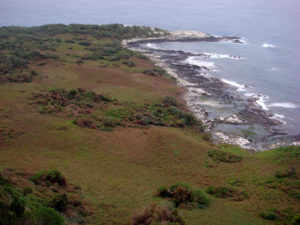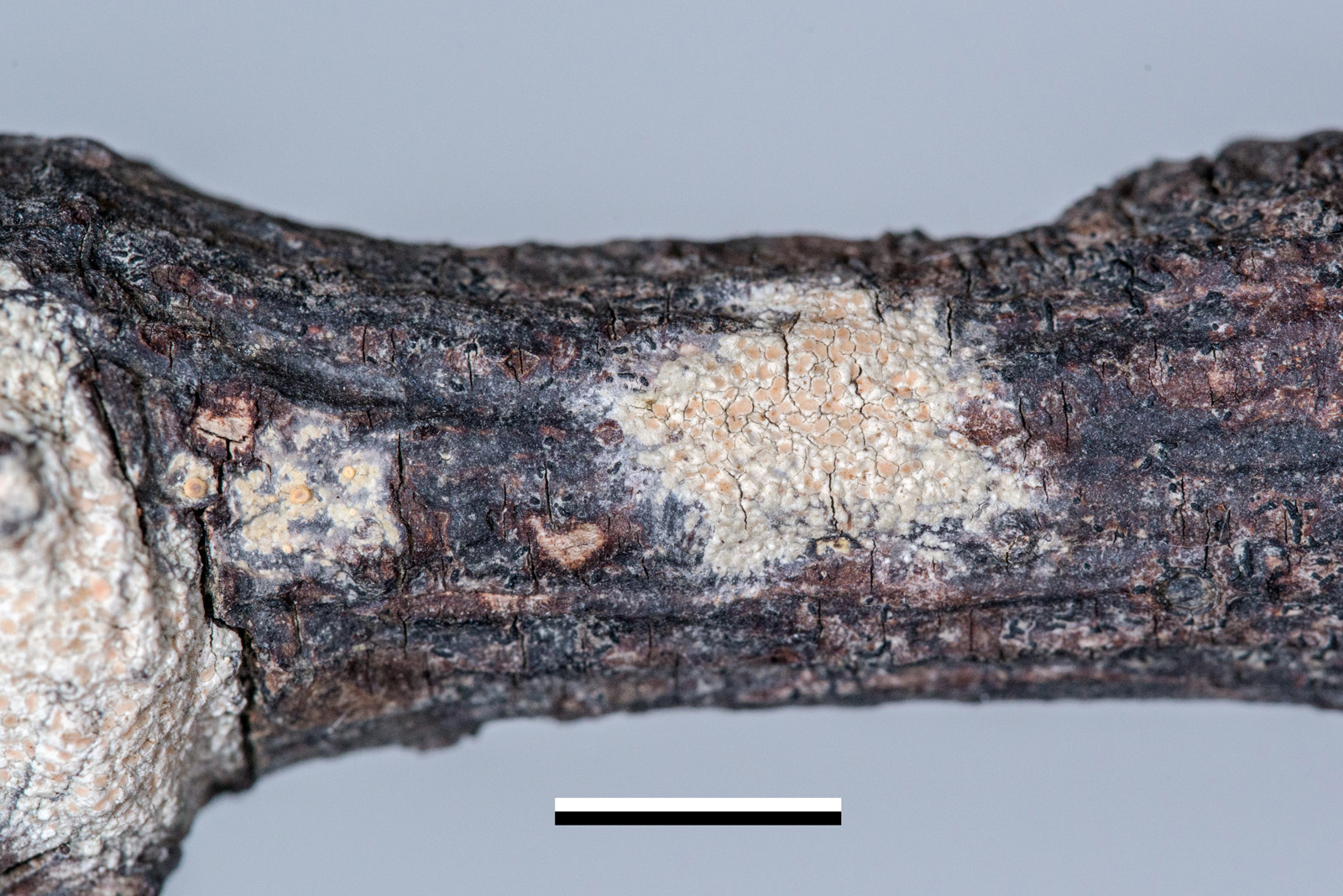The Chatham Islands group comprise the eastern most extension of the New Zealand Botanical Region. The islands lie 800 km east of Christchurch, and take anywhere from two and half to three hours by plane to reach. The two main islands, Rekohu (Chatham Island) and Rangiuria (Pitt Island) are populated by c.650 people. The main driver of the local economy is marine-focussed, the islands are famous for their crayfish, paua and blue cod. However, sheep and cattle are still farmed, and eco-tourism ventures are on the increase. The biota of the islands is world famous, the islands sporting such treasures as the Chatham Island forget-me-not (Myosotidium hortensia), and black robin (Petroica traversi). Although the fern and flowering plant flora is very well known, data on the islands bryophytes, fungi and lichens is still unavailable.
A DOC ‘Botanical’ Survey was undertaken during the annual mid-winter Chatham Island petrel (Pterodroma axillaris) burrow maintenance that is conducted by DOC staff preparatory to the next petrel breeding season. During the July visit, aside from checking burrows, counting black robins assessing storm damage and undertaking routine weed control and track clearing, it was intended to update the vegetation map for the island, and investigate the vegetation succession within areas of pohuehue (Muehlenbeckia aff. australis) vineland (Fig.1). Oddly Rangatira, despite its global significance as the staging post for the recovery of the critically endangered black robin has had little documentation of its flora. In part this may be because, with an understandable focus on the conservation management of black robin and Chatham Island petrel, most shore parties have been ornithological rather than botanical. That said there has been considerable research effort undertaken to investigate the vegetation succession of the island in the last 20 years. In particular study has focussed on the pohuehue vineland which many bird experts believe is an impediment to the natural forest recovery of the island. Simply put – more forest is needed if we are to have more black robins. To achieve that goal some people wondered if suppressing the pohuehue and planting those areas with forest trees would accelerate vegetation recovery, and so produce more bird habitat?
Critical to answering this question is the need is to determine the current vegetation associations of the island. Without that data, it is difficult to predict the likely future vegetation succession of the island. So, in July 2015 Peter de Lange set out to try and gather that data. Further in addition to vegetation mapping it was decided to update existing knowledge of the islands flora, and also its fungi and lichens – the latter are two life forms rarely noted by scientists visiting Rangatira.

Fig. 1. North-eastern portion of Rangatira(South-East Island) viewed from the Trig Station. Much of the flat expanse of vegetation is pohuehue (Muehlenbeckia aff. australis) vineland. Image: P.J. de Lange
As Rangatira was once so extensively modified (the island had been farmed), the flora and vegetation of the island though recovering lacks the diversity of that seen in similar habitats on nearby Rangiauria (Pitt Island). Of course, it’s also true that the much smaller size of Rangatira limits the floral diversity – so one would expect less diversity. Nevertheless, following on from the July 2015 survey, and working through the myriad fungal and plant collections housed in New Zealand Herbaria an interim assessment of the flora for Rangatira is that there are 182 indigenous and 68 naturalised fern and flowering plants (including five hybrids and seven (possibly new to science) ‘species’), one hornwort, 28 liverworts (one of which is naturalised to the Chatham Islands) and 50 mosses (including one naturalised to the islands) Four fungi and 119 lichens have also been recorded. Whilst the values for the fern and flowering plant taxa is probably pretty accurate more work is needed for the hornwort, liverwort and mosses – plant groups rarely collected by island visitors. Similarly, there will be more fungi on the island and without doubt many more lichens.
With respect to the lichens, those of Rangatira are, with few exceptions, crustose, often drab species that are easily missed in the gloomy forest. It is only on the exposed coastal cliff faces, shore platforms and rock outcrops of Rangatira that lichens, at least visually, dominate. In particular the white ‘paint’ of Pertusaria graphica forms a distinctive band on the rocks just above the spray zone, and on the islands exposed cliff faces and boulder fields. In places, this is broken by the Dufourea ligulata a species which, depending on the degree of exposure can be yellow, orange or very dark fiery orange. Whilst the rock dwelling lichens of Rangatira are visually conspicuous those of the forest are not; most are scarcely evident, blending with the bark of the trees, shrubs and vines they inhabit. Some are so inconspicuous that they are only seen when the host plant is carefully inspected by torch light or using an ultra violet lamp. There are some occasional surprises though.
One such surprise was found the exposed stems of pohuehue near Western Landing (Fig. 2 and header photo), and again on the bark of mahoe (Melicytus chathamicus). In the field, this lichen presented as a small, whitish crustose ‘scab’. The ‘scab’ on closer inspection sported numerous pinkish depressions (Fig. 2 and header photo). When later examined at the Unitec Herbarium laboratory by Dan Blanchon, thin sections of these immersed pinkish spots revealed that they were fruiting bodies (apothecia) and the spores extracted from these placed the lichen into the genus Lecanora, a species-rich genus of 600 or so taxa. Blanchon extracted DNA from the specimen, and used DNA sequencing in an attempt to place this enigmatic specimen into a known species. The results were more confusing than helpful, placing the lichen within the genus Lecanora, but not matching any known species.

Fig. 2. Portion of the type specimen (UNITEC 7497) of Lecanora kohu (left hand side: dry state / right hand side: wet state) showing an example of the new lichen on the branchlet of pohuehue (Muehlenbeckia aff. australis). Image: J.R. Rolfe
Images were taken and passed to experts in the USA (Field Museum, Chicago, Michigan State University, Michigan) and Senckenberg Institute, Germany. These elicited sufficient interest that duplicate material was sent to Michigan, and from there to Frankfurt. Initially it was decided that the Rangatira Lecanora was L. confusa, itself of interest as it would have been a new record for the New Zealand Archipelago. Then it was thought the specimens matched an undescribed species from the Falkland Islands. Finally, it was decided that they were in fact a new species.
This odyssey has culminated in the formal recognition of a new species, named Lecanora kohu (‘kohu’ from Te Reo Maori for ‘fog / mist’ in allusion to the sea fog that often obscures Rangatira) (Printzen et al. 2017). The new species is so far only known from the two July 2015 collections made from Rangatira. The species is not present in the other more extensive lichen collections from Rangiauria (Pitt Island) and Rekohu (Chatham Island) but it is probably present there as well. Indeed, any claim to Lecanora kohu being endemic to the Chatham islands would be rather unwise. Previous claims of an endemic Caloplaca, C. maculata, known only from Chatham Island, on coastal cliffs near Waitangi proved unfounded when the species turned up at Akatore, near Dunedin, South Island New Zealand (de Lange 2012). Only time and further collecting will tell whether Lecanora kohu occurs anywhere else in the world.
In the meantime, the discovery of Lecanora kohu on pohuehue and associated mahoe in the regenerating vegetation of Rangatira serves as a pertinent reminder of the need to carefully inventory the biota of a place before deciding on management actions. Currently Lecanora kohu is only known from Rangatira, and we know very little about its abundance, and habitat preferences there. We need more information. Also considering its chance discovery, one wonders what hitherto unrecognised biota also resides within the successional vegetation of Rangatira?
Acknowledgements
For assistance in the field on Rangatira during July 2015 Peter would like to thank Bex Bell and James Maunder then staff working for the Department of Conservation Chatham Island Area Office, and Dave Houston, Distributed Technical Advisor, Northern Terrestrial Ecosystems Unit, Department of Conservation. The process of describing Lecanora kohu was undertaken in a series of skips and jumps around the world starting with Thorsten Lumbsch of the Field Museum, Chicago, USA who suggested we follow up the find with Alan Fryday of the Michigan State University, USA and Christian Printzen of the Senckenberg Research Institute, Frankfurt, Germany. We also would like to thank Jack Elix, Australian National University, Canberra, Australia and Robert Lücking, Botanischer Garten und Botanisches Museum Berlin, Germany for offering a constructive review on the paper we subsequently wrote describing Lecanora kohu with Alan, Christian, Dave and Jeremy Rolfe. Jeremy Rolfe kindly supplied the images of Lecanora kohu based on the Holotype lodged in UNITEC.
References
de Lange, P.J. 2012: Sole Chatham Islands endemic lichen discovered on south Otago Coastline. Chatham Island New Zealand website. [accessed 2017 August 30]. http://www.chathams.co.nz/index.php/naturalheritage/138-lichen-no-longer-endemic
de Lange, P.J.; Heenan, P.B.; Rolfe, J.R. 2011: Checklist of vascular plants recorded from the Chatham Island Islands. Department of Conservation, Wellington. 57pp.
de Lange, P.J., Heenan, P.B.; Rolfe, J.R. 2013A. Uncinia auceps (Cyperaceae): a new endemic hooked sedge for the Chatham Islands. Phytotaxa 104: 12–20.
de Lange, P.J.; Heenan, P.B.; Houliston, G.; Rolfe, J.R.; Mitchell, A.D. 2013B: New Lepidium (Brassicaceae) from New Zealand. PhytoKeys 24: 1–147.
Printzen, C.; Blanchon, D.J.; Fryday, A.M.; de Lange, P.J.; Houston, D.M.; Rolfe, J.R. 2017: Lecanora kohu, a new species of Lecanora (Lichenized Ascomycota: Lecanoraceae) from the Chatham Islands, New Zealand. Submitted: New Zealand Journal of Botany 55. DOI: 10.1080/0028825X.2017.1364274
Contact
Dr Peter de Lange
pdelange@unitec.ac.nz
Dr Dan Blanchon
dblanchon@unitec.ac.nz
Header Photo: Close up of a rehydrated (wet) thallus portion of Lecanora kohu (UNITEC 7497) showing the distinctive. Immersed ‘pinkish’ fruiting bodies (apothecia). Image: J.R. Rolfe

Leave a Reply